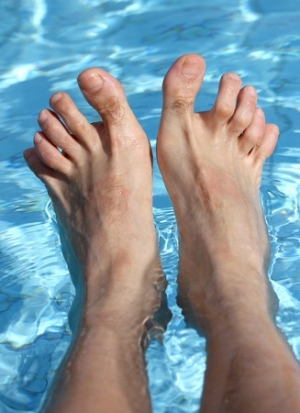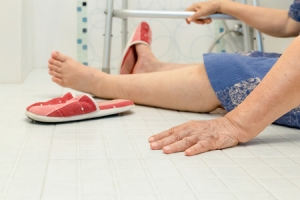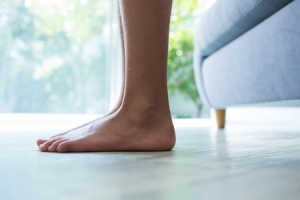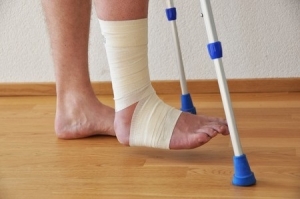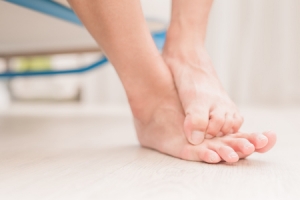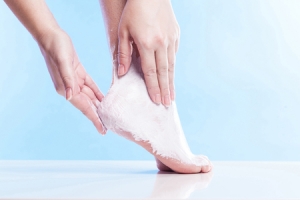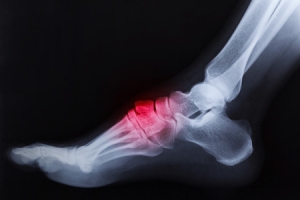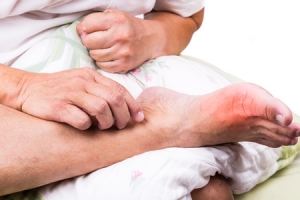Connect With Us
Blogs
Myths about Hammertoes
At Superior Foot & Ankle Care Center we often find that patients have no trouble identifying a hammertoe—its telltale downward bent at the joint makes it fairly obvious—but often that’s where the knowledge stops. Too often patients suffer for a long time with a hammertoe because they do not fully understand the condition and their treatment options. Below some common myths about hammertoes are dispelled to help patients be more informed about this condition:
MYTH: Hammertoes are caused by shoes that are too tight.
TRUTH: It’s true that improperly fitting shoes can contribute to or exacerbate the condition of hammertoe but usually a muscle/tendon imbalance predisposes the toe to bend downward. In some cases, one toe is longer than the others and pushes up against the front of the shoe. Hammertoe can also be genetic, the result of arthritis or a neurological or structural issue.
MYTH: It’s possible that over time hammertoes will get better without treatment.
TRUTH: Hammertoes are a progressive condition. Although they may progress at varying rates they will not improve and will, in fact, worsen to the point of being disabling if not treated. It’s important to have one of our podiatrists, Dr. Victoria Foley and Dr. Constance Omelas examine your hammertoe to assess how far it has progressed. The foot doctor may order x-rays to get a better look at the current state of the joint and will also want to get a complete medical history. Hammertoes should be monitored by the podiatrist.
MYTH: There’s no real treatment for hammertoes.
TRUTH: Actually there are several conservative options available to the foot doctor to help decrease pain, increase comfort and slow the progression of a hammertoe. These include: strapping or taping the toe to establish realignment, using a custom orthotic device to correct or compensate for a muscle tendon imbalance and doing stretching and other exercises to increase flexibility and strengthen supporting muscles. In addition, patients should choose shoes with low heels that have roomy toe boxes and are made of soft materials to avoid further stress to the toe and irritations such as corns, calluses, and ulcers from developing. If none of these treatments are successful or there are other deformities such as bunions in addition to the hammertoe the foot doctor may recommend surgery to correct the problem.
You have options so don’t suffer needlessly. If you have a hammertoe contact us for an appointment at our Long Beach office today by calling: 562-420-9800.
Focus on Senior Foot Care
As we age there are parts of the body that begin to experience “wear and tear” resulting in an increase in certain health problems. Your feet are no exception. At Superior Foot & Ankle Care Center, however, we believe that our senior patients can live active lives if they are proactive in the care of their feet and know how to prevent common foot problems. Below are some areas of concern for seniors:
Fall Danger – falls are a primary cause of injury in older patients and your feet obviously play a big role in keeping you upright. Observe the following precautions:
- Wear shoes that fit properly and are not worn out. Stretched out shoes or those with rips in them can cause you to trip more easily. Shoes that are too big or too small can alter the way you walk and also lead to a fall. Get your foot professionally measured at the shoe store because your size can change as you age.
- Fall-proof your home. Remove clutter, throw rugs and low plant stands, magazine racks, and other tripping hazards. Be sure there is adequate lighting inside and outside your home. Install handrails on both sides of all stairs.
- Get foot pain treated promptly. When your foot or ankle hurts you try to walk in a way that reduces the pain. This will throw off your balance and increase your risk of falling. Let our podiatrists, Dr. Victoria Foley and Dr. Constance Omelas, evaluate your feet and prescribe the correct treatment to protect the health of your feet.
Circulation – maintaining good circulation is necessary for keeping your feet healthy and also for healing any injuries to the lower extremities. Don’t smoke as this impedes circulation and exercise regularly. Keep the blood flowing! Do not sit or stand in one position for a long period of time.
Healthy Lifestyle – in addition to exercise, watch what you eat. Choose a nutrient-dense diet that will keep bones strong, help you have maximum energy and maintain an appropriate weight. Being overweight increases the risk of foot and other health issues. Keep up with all your medical checkups and listen to your body. Many foot ailments have early warning signs that can signal the need for attention.
If you have additional questions about senior foot healthcare contact our Long Beach office at (562) 420-9800.
Dealing with Flat Feet
A condition that we see frequently at Superior Foot & Ankle Care Center is flat feet. True to its name, “flat feet “describe a deformity in the foot where the arch of the foot is virtually nonexistent when a patient is standing. Although for many patients flat feet are not initially painful, they can lead to pain in the ankle, lower leg or middle of the foot. Having flat feet also makes you more susceptible to some other foot conditions such as plantar fasciitis. In addition to pain, flat feet can cause swelling and a lack of flexibility in the foot.
Who Gets Flat Feet?
There are several possible causes of flat feet. For some patients, the arch of the foot fails to develop properly during childhood. In other cases, it is something that occurs over time as the result of risk factors such as:
- Heredity
- Trauma or injury
- Aging
- Weight gain or pregnancy
- Arthritis
What Can be Done?
The course of treatment for flat feet will depend on the severity of the symptoms. Whether you have pain or not, if you notice that your feet seem to be flat and the floor without a normal arch you should contact our Long Beach office so that our podiatrists, Dr. Victoria Foley and Dr. Constance Omelas can examine your feet. Due to the possible genetic component of the condition, the foot doctor will want to get a family medical history as well. At the very least, the podiatrist will want to monitor your flat feet to ensure that a progressive disability does not develop over time. If you do have stiffness or pain the foot doctor may suggest any or all of the following:
- Stretching
- Physical therapy
- Icing
- Using arch supports or foot braces
If conservative measures don’t work or the arch issue is severe, reconstructive surgery may be an option.
If you have questions about flat feet or want to make an appointment to have your arches evaluated call us at 562-420-9800. We offer appointments before and after work and our helpful staff will work with you to find a time that works best with your busy schedule.
3 Foot Care Tips for Getting in Shape
If you are like many of our patients at Superior Foot & Ankle Care Center the New Year is a time to renew your commitment to getting physically fit. This is a worthy resolution that will benefit your feet and your entire body. Improved circulation, maintaining a healthy weight, decreased risk of heart disease and high blood pressure and stress relief are among the many benefits of regular exercise. Before you get started, however, we’d like to make the following suggestions to protect your feet and increase the enjoyment of your fitness program.
Get a Checkup—it’s a good idea to meet with our podiatrists, Dr. Victoria Foley and Dr. Constance Omelas and discuss your fitness goals and how you hope to achieve them. Some exercises put more stress on your feet than others. It’s important to have a complete examination of your feet and ankles and to have the foot doctor address any ongoing problems that you may be having. Sometimes special orthotics or padding may be recommended to protect a vulnerable area and make exercise more comfortable. The foot doctor can also make specific recommendations regarding shoes that suit your gait and foot.
Shop for Shoes—if you are going to be trying out a new activity go to a professional sports shoe store to get the correct footwear for your sport. Sports shoes are designed specifically for the types of movement required for specific activities. You should have your foot measured and also let the shoe salesperson know about any foot issues you have. You can avoid blisters by wearing shoes that are the correct size and don’t rub anywhere on your foot. Be sure to pick up some absorbent socks as well. Keeping feet dry is essential to avoid athlete’s foot and other fungal infections from developing.
Don’t Skip the Conditioning—properly warming up and stretching the ligaments, tendons and muscles in your lower legs and feet before and after exercise can help you avoid common injuries such as shin splints, Achilles tendonitis and plantar fasciitis.
If after you begin an exercise routine you notice pain in your toes, feet, ankles, calves or shins, be sure to make an appointment at our Long Beach office by calling: 562-420-9800. Continuing to work out while you are in pain will cause way more harm than good.
Protect Your Ankles
When you twist your ankle bones with a significant amount of force the ligaments around the outside of the bone may get over stretched or even tear. This is the definition of an ankle sprain. Symptoms of a sprained ankle include swelling, bruising, pain and tenderness in the ankle. At Superior Foot & Ankle Care Center we know that these injuries can be painful and debilitating. That’s why we want to offer the suggestions below for preventing ankle sprains from happening:
- Seek treatment promptly if you believe you may have sprained your ankle. Being able to walk on your foot is not a sign that the ankle is okay. In fact sometimes the pain may decrease after the initial injury but a sprain that is not diagnosed and treated promptly may not heal properly.
- Finish all treatment prescribed by the podiatrist for an ankle sprain. Did you know that one of the chief causes of ankle sprains are previous ankle sprains that were not fully rehabilitated? Don’t make the mistake of discontinuing physical therapy just because you are no longer in pain. In addition to the overstretched ligaments being healed it is necessary for the muscles that support the ligaments to be retrained and strengthened. If this does not occur, repeated sprains are likely and can result in chronic weak ankles.
- Scope out your path. Sometimes an acorn or small stone can be enough to cause your ankle to turn. Uneven pavement and curbs are also prime ankle twisting culprits. Pay attention!
- Don’t overfill your arms. If you are carrying so many bags and packages that you can’t see the pavement in front of you a slip or ankle turn is more likely.
- Toss shoes that are worn out. Stretched out backs and loose stitching increase the risk of slips and your ankle giving out on you.
If, despite all precautions, you do twist your ankle, contact our Long Beach office as soon after the injury as possible by calling: 562-420-9800. Our podiatrists, Dr. Victoria Foley and Dr. Constance Omelas will examine your ankle and possibly order x-rays to diagnose the condition. The correct treatment can then be determined to get you back to full health.
6 Ways to Prevent Diabetic Foot Complications
Here at Superior Foot & Ankle Care Center we believe in the importance of good foot care for all or our patients. For those with diabetes, however, extra precautions are necessary. Diabetes has several conditions associated with it that can result in major medical complications being caused by what other patients may deem minor foot issues. A compromised immune system, reduced circulation and neuropathy (or lack of sensation) all require additional measures to keep feet safe and healthy. Below are 6 podiatric tips for patients with diabetes:
- Choose footwear carefully. Shoes should have roomy toe boxes that don’t cramp or squeeze toes together. This will reduce the risk of ingrown toenails. Shoes should be made of natural, breathable materials. Inspect shoes periodically to make sure there are no rough spots, loose stitching or other elements that could rub on the skin and cause a blister or ulcer.
- Watch the heat. Don’t expose feet to high temperatures from fire places or electric blankets. Carefully monitor water temperature in baths and showers. A loss of sensation can result in burns due to the fact that the patient does not perceive pain from heat or burning.
- Stay dry. Fungi love moist, dark places to grow, such as the inside of sweaty socks. Change socks as soon as you notice they are damp to help avoid fungal infections.
- Keep the blood flowing. You can help improve circulation by exercising regularly and not sitting or standing in one position for long periods of time. Don’t cross your legs or wear socks that are tight or have elastic in the top to hold them up.
- Inspect feet daily. Wash your feet in warm soapy water every day and while you do so, check for cuts, blisters, bumps, bruising, swelling, growths or anything unusual or different on your feet. Report any changes to the foot doctor promptly.
- Make your podiatrist a care partner. Regular podiatric checkups with our podiatrists, Victoria M. Foley and Dr. Constance Ornelas can go a long way toward prevent footing health problems. If seen regularly, the foot doctor can detect changes and potential issues in your feet in the very earliest stages and stop problems before they start.
If you are a patient with diabetes and you have questions about the health of your feet, contact our Long Beach office by calling: 562-420-9800.
Give Your Feet a Gift this Holiday
Tis’ the season for shopping, baking, mailing and attending festive gatherings. And who is it that enables you to enjoy all the merry making of the holiday season? It’s your feet! At Superior Foot & Ankle Care Center we’d like to suggest some great gift ideas for those two very helpful parts of your body.
Moisture Wicking Socks—if you’re a sports enthusiast or just someone who’s on the go all the time these socks will whisk perspiration away from your feet. They can also be the inner layer of a double pair of socks if a ski vacation or other colder climate trip is part of your holiday plans. Keeping feet dry helps them stay warm and can prevent fungal infections (which love moist, dark places) from developing.
Insulated Water Bottle—you may not see the immediate connection to your feet on this one but drinking plenty of water is one way to prevent edema or swelling of your lower legs, ankles and feet. This means less pain at the end of a long day.
New Pair of Walking or Running Shoes—treat your feet to top quality exercise shoes. Have your foot professionally measured at a store that specializes in fitness footwear. Be sure to tell the shoe salesman about any conditions you have such as plantar fasciitis, flat feet or overpronation. Shoes that fit properly and accommodate any deformities or existing conditions will make exercising much more pleasurable and less likely to cause an injury. An added bonus: if you’re motivated to exercise you’ll have an easier time maintaining a healthy weight—a positive factor in preventing several foot disorders.
Super Emollient Foot Cream—nothing says “thanks” like a foot massage at the end of the day with a rich lotion or cream. Feet will stay moist and supple and unlikely to develop cracks or red, flaky patches.
Podiatric Checkup—if you’ve been putting off a visit to the foot doctor to find the source of a nagging pain, stiffness or something unusual that you’ve noticed on one of your feet this may be the best gift of all. Our podiatrists, Dr. Victoria Foley and Dr. Constance Omelas will not only diagnose any discomfort you’ve been experiencing, they can also help make recommendations for shoes that will best suit your individual foot and the activities you do. To make an appointment, contact our Long Beach office at: 562-420-9800.
Stress Fractures and Vitamin D
With approximately 25% of all the bones in your body residing in your feet, fractures are an important concern here at Superior Foot & Ankle Care Center. A general fracture, one that goes all the way through a bone, usually occurs as the result of an accident or other trauma and is immediately apparent. There is a second kind of fracture, however, that is not always so obvious: a stress fracture. Stress fractures are tiny fissures or cracks in the surface of a bone. They typically occur in the area from the middle of your foot extending to your toes, also called the forefoot.
Symptoms of a stress fracture are similar to those of a general fracture:
- Pain
- Swelling
- Bruising at the site of injury
- Tenderness
- Difficulty bearing weight on the affected foot
The difference, however, is in the way the symptoms present. Often with a stress fracture the discomfort will be intermittent; worse when you are active and on your feet and better when you are resting your foot. That’s why it’s important to make an appointment at our Long Beach office if you experience any of the above symptoms even if they don’t seem very intense. Our podiatrists, Dr. Victoria Foley and Dr. Constance Omelas will be able to determine if you have a stress fracture or if your symptoms are due to another condition.
One important way that you can help prevent stress fractures is by making sure that you have an adequate intake of vitamin D. Although calcium seems to get all the credit when it comes to bone strength, it’s actually vitamin D that enables your body to absorb and regulate the calcium.
Many people have a vitamin D deficiency and don’t even realize it. Vitamin D deficiencies are more common if you have one or more of the following factors:
- Being over 50
- Limited sun exposure (the sun being a good source of vitamin D)
- Dark complexion
- Overweight
- A medical condition that causes fat malabsorption
Your doctor can do a blood test to check your vitamin D levels.
Other ways to help prevent stress fractures include avoiding injury and repetitive activities that put pressure on the forefoot. If you believe you may have a stress fracture contact us by calling: 562-420-9800.
Holiday Shopping May Inflame Varicose Veins
Perhaps you never even noticed them before or maybe those unsightly veins were something you saw but didn’t think twice about because they weren’t bothering you in any way. During the holiday season, however, we at Superior Foot & Ankle Care Center often see an increase in the number of patients complaining about this disorder. Why? Standing for long periods of time—such as waiting on long lines to purchase your holiday gifts—puts extra pressure on veins and can result in pain and discomfort.
If you have varicose veins, you may notice that after a day at the mall your legs feel heavy and achy. The skin around the veins may be itchy or dry and the veins may actually throb or hurt. It’s not uncommon to have swelling in your feet, ankles or lower legs as well.
Getting Relief
If this occurs, it’s a good idea to make an appointment at our Venice office so that our podiatrists, Dr. Victoria Foley and Dr. Constance Omelas can examine your legs and feet. In some cases, varicose veins can signal a problem with your circulatory system. There are several conditions such as diabetes and peripheral vascular disease that are associated with blood flow issues. The doctor will want to rule out a more serious condition.
The treatment for your veins will depend on the source and the foot doctor will go over the options available and the best one for your particular situation. In some cases, the podiatrist will recommend minimally invasive surgery or laser therapy. Most often, however, conservative measures can be utilized to lessen the irritation to the veins. These include:
- Wearing compression stockings
- Elevating the legs, especially at the end of the day
- Avoiding sitting or standing for long periods of time; take breaks if your job requires hours at your desk or standing up
- A consistent exercise routine
- Weight loss if you are currently overweight as this puts additional strain on your veins
If you are concerned about varicose veins or have additional questions about this condition, contact us by calling: 562-420-9800.
Eat this Not That During the Holidays
A common concern during this festive time of the year is navigating all the rich, calorie-laden holiday food offerings. From Christmas cookies to eggnog to roasts, to chips, dips, and other classic favorites menus can be landmines just waiting to blow up your healthy eating plan. At Superior Foot & Ankle Care Center we know that what you eat also impacts the health of your feet. Your feet carry the weight of your entire body and when you are overweight or obese you significantly increase your risk for several foot conditions and can make existing disorders much worse. In addition, foods can trigger an inflammatory response in conditions such as arthritis and gout.
If you have a podiatric condition that is associated with inflammation check with one of our podiatrists, Dr. Victoria Foley and Dr. Constance Omelas, about the best strategies for relieving or preventing inflammation. In some cases the foot doctor may prescribe medication or other treatments. If the inflammation seems to be increasing it’s important for the podiatrist to re-evaluate your condition to check its progression and rule out other complications.
Below are some healthful swaps to keep in mind as you make your way around the party buffet:
- Eat nuts and berries instead of chips and pretzels. Not only are nuts and berries healthier choices they also help fight inflammation whereas chips and pretzels are made with refined flour that can increase inflammatory response.
- If you are prone to gout eat chicken instead of red meat.
- Choose sparkling seltzer or wine spritzers over multiple alcoholic beverages. Excess alcohol intake can trigger gout, increase inflammation and pack on the pounds.
- Pick the smoked fish over the fried oysters. Fatty fish are known to decrease inflammation while fried foods increase it and are also are much higher in calories.
- Load up on greens and salads instead of potatoes and rolls. If you plate your salads and vegetables first there will be less room for higher calorie foods.
Healthy eating is just one way to protect your feet this holiday season. If you have questions about your feet and how to best care for them contact our Long Beach office by calling: 562-420-9800.
